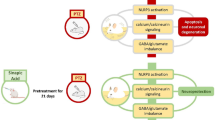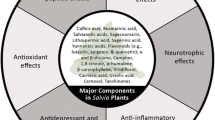Abstract
Scientific pieces of evidence support the pharmacological activity of Curcuma caesia for its antidepressant, analgesic, anticonvulsant and antioxidant effect. Here, we evaluate the bioactivity of essential oil and the various polarity-based solvent partitioned fractions obtained from Curcuma caesia for anti-amnesia, anxiolytic and antidepressant activities using Elevated plus maze and Morris water maze models. The cold maceration technique using methanol was adopted for extraction from dried powdered rhizomes and essential oil was extracted by hydrodistillation method. Partitioning of the methanolic extract based on solvent polarity by hexane, ethyl acetate, and methanol was continued, followed by column chromatography of the ethyl acetate fraction. Suspensions were prepared for fractions (dissolved in distilled water) and essential oil (dissolved in tween 20) at 200 mg/kg and 400 mg/kg after acute toxicity study and were orally administered to Wistar albino female rats after the orientation of hypoxia by sodium nitrite (50 mg/kg) and amnesia by scopolamine (1 mg/kg). Behavioural observations, biochemical and histopathological examinations were carried out for all the treated groups. Diazepam (12 mg/kg) and galantamine (3 mg/kg) were used as standard drugs for this study against hypoxia and amnesia. Data acquired from behavioural, biochemical (acetylcholinesterase, myeloperoxidase, superoxide dismutase, reduced glutathione, catalase) and histopathological studies have illustrated that fraction II acquires highly significant memory-enhancing, anxiolytic and antidepressant effects. Rest fractions (I and III) and essential oil showed moderate efficacy. In prospects, identification of active molecules from the most active fraction (fraction II) and further studies on a molecular basis would substantiate its specific mechanism of neuroprotective action.







Similar content being viewed by others
Abbreviations
- Nos.:
-
Numbers
- RNS:
-
Reactive Nitrogen Species
- OECD:
-
Organization for Economic Co-operation and Development
- EPM:
-
Elevated plus maze (EPM)
- MWM:
-
Morris water maze
- cm:
-
Centimeter
- GSH:
-
Reduced glutathione
- Cat:
-
Catalase activity
- SOD:
-
Superoxide dismutase
- MPO:
-
Myeloperoxidase
- DTNB:
-
5′ dithionitrobenzoic acid
- mM:
-
MilliMolar
- EDTA:
-
Ethylenediamine tetra acetic acid
- TCA:
-
Tricholoacetic acid
- g:
-
Gram
- O.D.:
-
Optical density
- UV–Vis spectrophotometer:
-
Ultraviolet–visible spectrophotometer
- H2O2 :
-
Hydrogen peroxide
- SEM:
-
Standard error of the mean
References
Abu F, Norma C, Taib M, Aris M, Moklas M, Akhir SM (2017) Antioxidant properties of crude extract, partition extract and fermented medium of Dendrobium sabin flower. Evid Based Complement Alternat Med 2017:1–9
Adhami F, Liao G, Morozov YM, Schloemer A, Schmithorst VJ, Lorenz JN, Dunn RS, Vorhees CV, Wills-karp M, Degen JL, Davis RJ, Mizushima N, Rakic P, Dardzinski BJ, Holland SK, Sharp FR, Kuan C (2006) Cerebral ischemia-hypoxia induces intravascular coagulation and autophagy. Am J Pathol 169:566–583
Aebi H (1984) Catalase in vitro. Methods Enzymol 105:121–126
Allen RJ (2018) Classic and recent advances in understanding amnesia. F1000 Res 7:1–9
Arulmozhi DK, Sridhar N, Veeranjaneyulu A, Arora SK (2006) Preliminary mechanistic studies on the smooth muscle relaxant effect of hydroalcoholic extract of Curcuma caesia. J Herb Pharmacother 6:117–124
Barua CC, Haloi P, Patowary P, Bora M, Barua AG, Bordoloi MJ, Barua IC (2015) Evaluation of anti-amnestic activity of few medicinal plants against scopolamine induced amnesia. Indian J Tradit Knowl 14:581–89
Borah S, Sarkar P, Sharma HK (2020) Chemical profiling, free radical scavenging, and anti-acetylcholinesterase activities of essential oil from Curcuma caesia of Arunachal Pradesh, India. Pharmacogn Res 12(1):76–84
Chaudhari KS, Tiwari NR, Tiwari RR (2017) Neurocognitive effect of nootropic drug Brahmi (Bacopa monnieri) in Alzheimer’s disease. Ann Neurosci 24:111–22
Chiu GS, Chatterjee D, Darmody PT, Walsh JP, Meling DD, Johnson RW, Freund GG (2012) Hypoxia/reoxygenation impairs memory formation via adenosine-dependent activation of caspase 1. J Neurosci 32:13945–55
Claudia MR, Bezerra TDS, Soares AC, Ramos RB, Carneiro FP, Vianna LMS, Faro LRF, Silva MV, Vieira MP, Monteiro IO, Ferreira VM (2017) Hippocampal and cerebellar histological changes and their behavioural repercussions caused by brain ischaemic hypoxia experimentally induced by sodium nitrite. Behav Brain Res 332:223–32
Das S, Zaman K (2013) Curcuma caesia Roxb. and its medicinal uses: a review. Int J Res 3:370–75
Devi HP, Mazumder PB (2018) Methanolic extract of Curcuma caesia Roxb. prevents the toxicity caused by cyclophosphamide to bone marrow cells, liver and kidney of mice. Pharmacogn Res 8:43–49
Ekanem PE, Ekanem R, Gaim K (2016) Histological patterns of neurodegeneration of frontal cortex neurons in Datura stramonium treated Wistar rats. J Behav Brain Sci 6:85–92
Ellman GL, Courtney KD, Valentino A Jr, Featherstone RM (1961) A new and rapid colorimetric determination of acetylcholinesterase activity. Biochem Pharmacol 7:88–90
Florent-Bechard S, Desbene C, Garcia P, Allouche A, Youssef I, Escanye MC, Koziel V, Hanse M, Malaplate-Armand C, Stenger C, Kriem B, Yen-Potin FT, Olivier JL, Pillot T, Oster T (2009) The essential role of lipids in Alzheimer’s disease. Biochimie 91:804–809
Fonseca-Santos B, Chorilli M, Palmira Daflon Gremiao M (2015) Nanotechnology-based drug delivery systems for the treatment of Alzheimer’s disease. Int J Nanomed 10:4981–5003
Foyet HS, Tsala DE, Bouba AA, Hritcu L (2012) Anxiolytic and antidepressant-like effects of the aqueous extract of Alafia multiflora stem barks in rodents. Adv Pharmacol Pharm Sci 2012:1–8
Francis PT, Palmer AM, Snape M, Wilcock GK (1999) The cholinergic hypothesis of Alzheimer’s disease: a review of progress. J Neurol Neurosurg Psychiatry 66:137–47
Garabadu D, Krishnamurthy S (2014) Diazepam potentiates the antidiabetic, antistress and anxiolytic activities of metformin in type-2 diabetes mellitus with co-occurring stress in experimental animals. BioMed Res 2014:1–15
Garry PS, Ezra M, Rowland MJ, Westbrook J, Pattinson KTS (2015) The role of the nitric oxide pathway in brain injury and its treatment—from bench to bedside. Exp Neurol 263:235–243
Gueroui M, Kechrid Z (2016) Evaluation of some biochemical parameters and brain oxidative stress in experimental rats exposed chronically to silver nitrate and the protective role of vitamin E and selenium. Toxicol Res 32:301–309
Handley SL, Mithani S (1984) Effects of alpha-adrenoceptor agonists and antagonists in a maze-exploration model of ’fear ’-motivated behaviour. Arch Pharmacol 327:1–5
Hossain MA, Hdhrami SSA, Weli AM, Riyami QA, Sabahi JNA (2014) Isolation, fractionation and identification of chemical constituents from the leaves crude extracts of Mentha piperita L. grown in Sultanate of Oman. Asian Pac J Trop Biomed 4:S368-72
Kagyung R, Gajurel P, Rethy P, Singh B (2010) Ethnomedicinal plants used for gastrointestinal diseases by Adi tribes of Dehang-Debang Biosphere Reserve in Arunachal Pradesh. Indian J Tradit Knowl 9:496–501
Kakkar P, Das B, Viswanathan PN (1984) A modified spectrophotometric assay of superoxide dismutase. Indian J Biochem Biol 21:130–32
Karmakar I, Dolai N, Saha P, Sarkar N, Bala A, Haldar PK (2011) Scavenging activity of Curcuma caesia rhizome against reactive oxygen and nitrogen species. Orient Pharm Exp Med 11:221–28
Karmakar I, Saha P, Sarkar N, Bhattacharya S, Haldar PK (2011) Neuropharmacological assessment of Curcuma caesia rhizome in experimental animal models. Orient Pharm Exp Med 11:251–55
Kheirbakhsh R, Haddadi M, Muhammadnejad A, Abdollahi A, Shahi F (2018) Long-term behavioral, histological, biochemical and hematological evaluations of amyloid beta-induced Alzheimer’s disease in the rat. Acta Neurobiol Exp 78:51–59
Kulkarni KS, Kasture SB, Mengi SA (2010) Efficacy study of Prunus amygdalus (almond) nuts in scopolamine-induced amnesia in rats. Indian J Pharmacol 42:168–73
Lawand RV, Gandhi SV (2013) Comparison of Curcuma caesia Roxb. with other commonly used curcuma species by HPTLC. J Pharmacogn Phytochem 2:126–131
Lee GY, Lee C, Park GH, Jang JH (2018) amelioration of scopolamine-induced learning and memory impairment by α-pinene in C57BL/6 mice. Evid Based Complement Alternat Med 2018:1–9
Mukunthan KS, Anil Kumar NV, Balaji S, Trupti NP (2014) Analysis of essential oil constituents in rhizome of Curcuma caesia Roxb. from South India. J Essent 17:647–651
Nampoothiri M, John J, Kumar N, Mudgal J, Nampurath GK, Chamallamudi MR (2015) Modulatory role of simvastatin against aluminium chloride-induced behavioural and biochemical changes in rats. Behav Neurol 2015:1–9
Nunez J (2008) Morris water maze experiment. J Vis Exp 2008:1–2
OECD (2001) Guideline for testing of chemicals 423. Acute Oral Toxicity Acute Toxic Class Method 2001:1–22
Owens CWI, Belcher RV (1965) A colorimetric micro-method for the determination of glutathione. Biochem J 94:705–711
Pandey A, Tripathi S (2014) Concept of standardization, extraction, and pre-phytochemical screening strategies for the herbal drug. J Pharmacogn Phytochem 2:115–119
Pellow S, Chopin P, File SE, Briley M (1985) Validation of open: closed arm entries in an elevated plus-maze as a measure of anxiety in the rat. J Neurosci Methods 14:149–167
Picciotto MR, Higley MJ, Mineur YS (2012) Acetylcholine as a neuromodulator: cholinergic signaling shapes nervous system function and behaviour. Neuron 76:116–29
Pulli B, Ali M, Forghani R, Schob S, Hsieh KLC, Wojtkiewicz G, Linnoila JJ, Chen JW (2013) Measuring myeloperoxidase activity in biological samples. PLoS ONE 8:1–10
Puri A, Srivastava P, Pandey P, Yadav RS, Bhatt PC (2014) Scopolamine induced behavioral and biochemical modifications and protective effect of Celastruspaniculatous and Angelica glauca in rats. Int J Nutr Pharmacol Neurol Dis 4:158–69
Reenu J, Azeez S, Bhageerathy C (2015) In vitro antioxidant potential in sequential extracts of Curcuma caesia Roxb. Rhizomes. Indian J Pharm Sci 77:41–8
Sahu B, Kenwat R, Chandrakar S (2017) Medicinal value of Curcuma caesia Roxb: an overview. UK J Pharm Biosci 4:69–74
Sarangthem K, Haokip MJ (2010) Bioactive components in Curcuma caesia Roxb. Grown in Manipur. Bioscan 5:113–115
Scott LJ, Goa KL (2000) Galantamine: a review of its use in Alzheimer’s disease. Drugs 60:1095–122
Tag H, Das AK, Loyi H (2007) Anti-inflammatory plants used by the Khamti tribe of Lohit district in eastern Arunachal Pradesh, India. Nat Prod Radiance 6:334–340
Tewari D, Stankiewicz AM, Mocan A, Sah AN, Tzvetkov NT, Huminiecki L, Horbanczuk JO, Atanasov AG (2018) Ethnopharmacological approaches for dementia therapy and significance of natural products and herbal drugs. Front Aging Neurosci 10:1–24
Zeb A, Sadiq A, Ullah F, Ahmad S, Ayaz M (2014) Phytochemical and toxicological investigations of crude methanolic extracts, subsequent fractions, and crude saponins of Isodon rugosus. Biol Res 47:1–6
Zhao Y, Zhao B (2013) Oxidative stress and the pathogenesis of Alzheimer’s Disease. Oxid Med Cell Longev 2013:1–10
Acknowledgement
The authors express their thanks to Council of Scientific and Industrial Research (CSIR), Govt. of India, New Delhi, for financial support. The authors are thankful to Botanical Survey of India, Eastern Regional Centre, Shillong, Meghalaya for authenticating the plant. The authors are also thankful to Institute of Advanced Study in Science and Technology (IASST), Guwahati, Assam for extending laboratory facility.
Funding
This research work received fund from Council of Scientific and Industrial Research (CSIR), HRDG, New Delhi under CSIR Direct SRF Scheme Vide File No. 09/857 (0010)/2018-EMR-I.
Author information
Authors and Affiliations
Corresponding author
Ethics declarations
Conflict of interest
The authors declare that they have no conflict of interest.
Rights and permissions
About this article
Cite this article
Borah, S., Sarkar, P. & Sharma, H.K. Analysing Curcuma caesia fractions and essential oil for neuroprotective potential against anxiety, depression, and amnesia. 3 Biotech 11, 240 (2021). https://doi.org/10.1007/s13205-021-02793-w
Received:
Accepted:
Published:
DOI: https://doi.org/10.1007/s13205-021-02793-w




